
The 1984–1985 United Kingdom miners' strike was a major industrial action within the British coal industry in an attempt to prevent colliery closures. It was led by Arthur Scargill of the National Union of Mineworkers (NUM) against the National Coal Board (NCB), a government agency. Opposition to the strike was led by the Conservative government of Prime Minister Margaret Thatcher, who wanted to reduce the power of the trade unions.

Bannockburn is an area immediately south of the centre of Stirling in Scotland. It is part of the City of Stirling. It is named after the Bannock Burn, a stream running through the town before flowing into the River Forth.
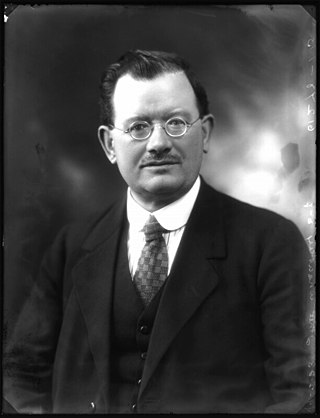
John Wheatley was a Scottish socialist politician. He was a prominent figure of the Red Clydeside era.

The Stirling council area is one of the 32 council areas of Scotland, and has a population of about 93,470. It was created in 1975 as a lower-tier district within the Central region. The district covered parts of the historic counties of Stirlingshire and Perthshire, which were abolished for local government purposes. In 1996 the Central region was abolished and Stirling Council took over all local government functions within the area.

Cowdenbeath is a town and burgh in west Fife, Scotland. It is 5 miles (8 km) north-east of Dunfermline and 18 miles (29 km) north of the capital, Edinburgh. The town grew up around the extensive coalfields of the area and became a police burgh in 1890. According to a 2008 estimate, the town has a population of 14,081.

Sacriston is a village and civil parish in County Durham, England, situated 3 miles (4.8 km) north of the city of Durham.

The National Coal Board (NCB) was the statutory corporation created to run the nationalised coal mining industry in the United Kingdom. Set up under the Coal Industry Nationalisation Act 1946, it took over the United Kingdom's collieries on "vesting day", 1 January 1947. In 1987, the NCB was renamed the British Coal Corporation, and its assets were subsequently privatised.
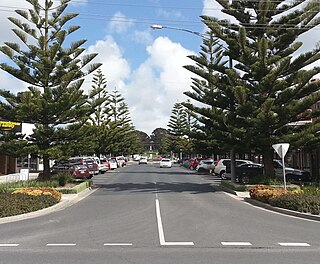
Wonthaggi is a seaside town located 132 kilometres (82 mi) south east of Melbourne via the South Gippsland and Bass highways, in the Bass Coast Shire of Gippsland, Victoria, Australia. Known originally for its coal mining, it is now the largest town in South Gippsland, a regional area with extensive tourism, beef and dairy industries.
The Miners' Federation of Great Britain (MFGB) was established after a meeting of local mining trade unions in Newport, Wales in 1888. The federation was formed to represent and co-ordinate the affairs of local and regional miners' unions in England, Scotland and Wales whose associations remained largely autonomous. At its peak, the federation represented nearly one million workers. It was reorganised into the National Union of Mineworkers in 1945.
Sir Ian Kinloch MacGregor, KBE was a Scottish-American metallurgist and industrialist, most famous in the UK for his controversial tenure at the British Steel Corporation and his conduct during the 1984–85 miners' strike while managing the National Coal Board.
Raploch, known locally as The Raploch or The Raptap, is a district of the city of Stirling, which lies to the south of the River Forth in central Scotland.

Armadale is a town within the county of West Lothian in the Central Belt of Scotland. It lies to the west of Bathgate and to the east of Blackridge. Armadale, formerly known as Barbauchlaw, is an ex-mining town which was also known for its brick manufacturing. It is named after Armadale in Sutherland, this estate being owned by Sir William Honeyman who later acquired the land of Barbauchlaw. Primarily a residential community, the town has a number of different public places, a central Mains Street and a series of parks, green spaces and nature reserves, many of which lie atop former mines and industrial areas.

Newtongrange is a former mining village in Midlothian, Scotland. Known in local dialect as Nitten, or Nitten by the Bing , it became Scotland's largest mining village in the 1890s, with the sinking of the Lady Victoria Colliery and a shaft over 1600 feet deep. This closed in 1981 but today houses the National Mining Museum, an Anchor Point of ERIH - The European Route of Industrial Heritage.
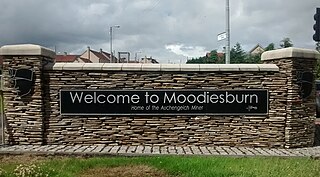
Moodiesburn is a village in Scotland, located 8 miles northeast of Glasgow, in the North Lanarkshire council area. It is situated on the north side of the A80 road and between the M73 and M80 motorways which converge nearby. Moodiesburn does not directly adjoin any other settlements, though the villages of Chryston and Muirhead are located a short distance to the west, with Stepps beyond, and outer parts of Cumbernauld lie to the east; however, the town centres are about 5 miles apart.

Hill of Beath ( is a hill and a village in Fife, Scotland, just outside Dunfermline and joined to Cowdenbeath.
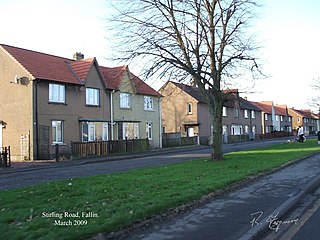
Fallin is a village in the Stirling council area of Scotland. It lies on the A905 road 3 miles east of Stirling on a bend in the River Forth. The United Kingdom Census 2001 recorded the population as 2,710.
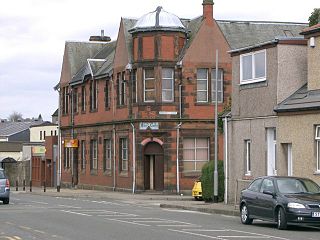
The Gothenburg or Trust Public House system originated in the 1860s in Gothenburg, Sweden, in an attempt to control the consumption of spirits. Earlier in the century, 34 litres annual per capita consumption of spirits was recorded in Sweden. In 1855 the country proscribed domestic distillation. The city of Gothenburg awarded its sole retail licence for spirits to a trust, with the aim of controlling consumption. The shareholders of the trust were to receive a maximum return of 5% annually and all other profits were to be used to benefit the local community. The town treasury was to control the income generated and use it to provide libraries, museums, parks and other community facilities. The success of the system led to its spread throughout Sweden and further afield.
Peter Bowling was an Australian coal miner and trade unionist.
The Scots Mining Company House, also known as Woodlands Hall, is an early-18th-century mansion house in Leadhills, South Lanarkshire, Scotland. The house was built around 1736 for the manager of the Leadhills mines, which were owned by the Earl of Hopetoun. Its design has been attributed to the architect William Adam.
Events from the year 1928 in Scotland.














